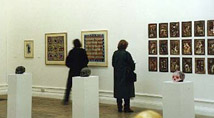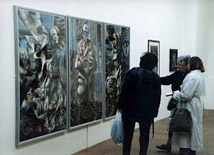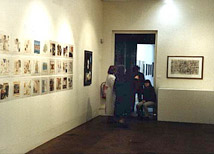Sacred & Profane/ Drawing to a Conclusion: Introduction by Bill Hurrell
I cannot think of a better way of talking about Tom Phillips and his many projects than to make a verbal tour around his studio. The last time I described it in 1992 for the introduction to the catalog of his Royal Academy exhibit the main workspace was full of large panels of lettering like giant miniatures from antique books. Another area was heaped with half-torn color supplements from newspapers which were turning into collages such as Brent Cross, while on the walls were some huge partly-erased sections of Rima's Wall and the newly finished panels of The Peeler.
Visiting with Tom again this year I found the same clutter but with different ingredients. Now the floor was strewn with the multicolored cards he and his helpers had gathered from the telephone booths of London. From these Tom was patiently cutting up little triangles and lozenge shapes and placing them one by one in ordered patterns ready to be mounted on fabric and sewn into a quilt. On nearby shelves a series of skulls was stacked; some in bronze or glass and others covered with paper from his usual sources, newspaper supplements and boys' magazines and the inevitable Human Document (with the addition to the armory of the hookers' announcements). One or two of the skulls were covered in different kinds of mud from a selection of preserve jars labelled 'Berlin' or 'Majorca' or 'Peckham'. One of the jars contained the characteristic red earth that he had used in his set designs for A Winter's Tale at the new/old Globe Theatre. The two skulls currently in progress were being coated with his own now piebald hair, one nearly black, one nearly white.
The only element common to the two inspections over five years apart was the new set of Peeler panels, some incomplete with only the pithyphallic orange skins in place.
No room in his home is anything but a studio whatever name it is given in the customary roster of domestic spaces. In what Tom calls his kitchen -- which boasts only the most rudimentary cooking and dining facilities and these often themselves difficult to locate under notes and papers -- I noted a pile of pages for the new edition of A Humument ready to send off to the Sackner Archive in Miami. A new feature however was a set of filing cabinets and albums which house his millennium project. Postcards have long played a part in his work -- as in the Berlin Wall painting and the huge Mappin Art Gallery installation. Now they are being filed neatly year by year to make a postcard history of the twentieth century based both on the cards and the messages they bear.
With glee he shows me two recent finds, a card of the Nazi Party Congress sent from Nuremberg in 1936 with a description by the sender of Hitler speaking, and an early card of the Beatles posted in 1963.
William Packer of London's Financial Times long ago pointed out this Little Jack Horner aspect of the artist's work and writings. The reference -- in a context of kindly criticism -- to a nursery-rhyme character was all too appropriate, for there is a genuinely childish delight that Tom takes in his discoveries and an equally intense dismay when he finds that delight unshared or misinterpreted. Whatever this has of vainglory it is a leavening to an approach to art that is often looked upon by critics as over-intellectual. Reference in his work is in fact as likely to be to Bugs Bunny as to Barthes.
Nothing gives this artist more pleasure than to knot together another pair of threads in the web of his work; whether it be to link old themes like the motif of the cross and his career-long preoccupation with script or to find that quilting echoes the tile-like procedures of his paintings of the seventies such as The Skin Game. Often he is by instinct a move ahead of himself, only seeing the connection with past subject matter or manner of operation after a piece is made. Then it is like two friends who have known each other for years and who suddenly decide to get married, which is precisely what happened to the artist and Fiona Maddocks in 1995. As a result of this I notice a new atmosphere of celebration in his output to which these two shows, distinctly different intriguingly linked, testify.
Bill Hurrell
Indian Head, Saskatchewan, 1997



